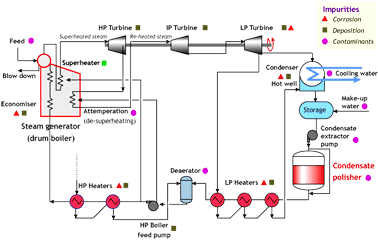Condensate polishing
basic principles
Turbine condensates in power stations
For process condensates, see below.
Fossil-fuelled (coal, oil, gas) and nuclear power stations produce electricity with turbines powered with high pressure steam. A schematic representation of this steam circuit is shown in the picture below. After going through the turbine, the steam is condensed and recycled.
To avoid deposits on the turbine blades and corrosion in the steam circuit, the steam must be extremely pure. However, being permanently recycled, the condensate collects corrosion and erosion products from the boiler and pipework, as shown in the picture. The contaminants in the condensate must have a concentration of a few µg/L (ppb) or less. Therefore, the condensate, in many (but not all) power stations, is treated with ion exchange resins, ion exchange being the only process capable of achieving these low residual values.
Many new power stations are being built, particularly in emerging countries such as India and China, so that the number of condensate polishing project has increased tremendously since the beginning of the 21st Century. Whilst ion exchange processes for water demineralisation were mainly developed in Europe, the champions of condensate polishing design are largely American.
Duties of a condensate polisher
The condensate polisher must fulfill two simultaneous duties:
- it must remove the "crud", wich is suspended solids (mostly metal oxides) resulting from corrosion and erosion;
- it must also remove any dissolved solids originating from the make-up water, possible leaks of the condenser, or from regeneration of the ion exchange resins.
This means that the polisher must perform filtration and demineralisation at the same time.
Most power stations use ammonia or amines to condition the water and steam circuit to reduce corrosion. As a result, the ionic load on the condensate polishing resin is largely cationic, and ammonium ions are removed together with lower concentrations of cations and anions in the condensate polisher.
Design options
In view of the low salinity of the water to be treated, mixed bed polishers are used in over 90 % of the cases. These units are usually designed for a high specific flow rate (80 to 120 bed volumes per hour). In large power stations, the flow rate through each condensate polishing unit is often 600 to 1000 m3/h. When the operating pressure is not too high, cylindrical vessels are used, but at 4 MPa (40 bar) or above, spherical vessels are necessary to keep the shell thickness within reasonable limits.
Click for details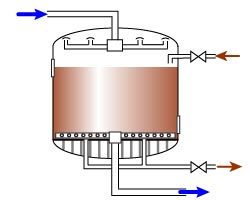 A cylindrical MB unit |
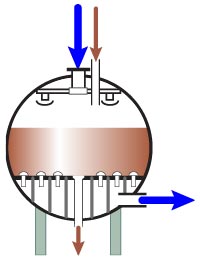 A spherical MB unit |
Other polisher designs are mentioned in the page about ion exchange columns.
Regeneration
In most cases, regeneration is external. This has two purposes:
- to avoid accidental ingress of regenerant chemicals in the water and steam circuit;
- to design the operating unit without internals, and with a low bed depth producing a relatively low pressure drop, whilst the regeneration station is designed with narrower columns and a high bed depth facilitating resin separation.
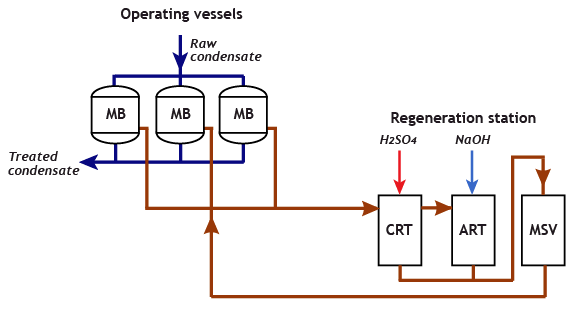
Condensate polishing system with external regeneration
The regeneration station has typically three columns, the first one (CRT = cation regeneration tower) used for backwash, cleaning and separation of the mixed resins and regeneration of the cation exchanger, the second one (ART = anion regeneration tower) for regeneration of the anion exchanger, and the last one (MSV = mixing and storage vessel) for mixing, fast rinse and storage of the regenerated resin.
The next picture gives more details about the regeneration process:
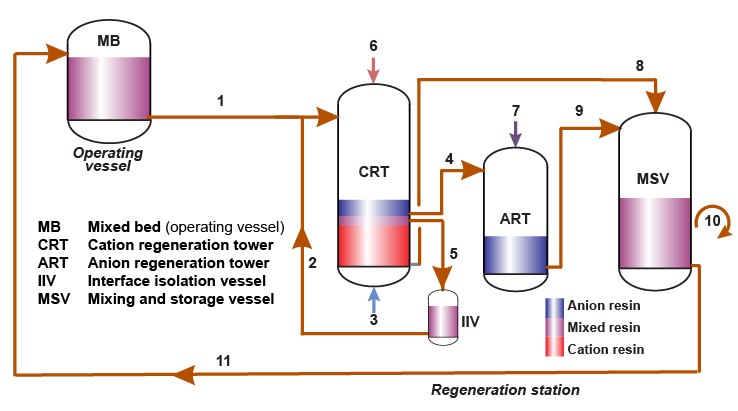
The individual steps are:
- Transfer of the full resin charge from the operating vessel (MB) to the cation regeneration tower CRT.
- Transfer of the small mixed resin stored in the interface isolation vessel IIV to the CRT.
- Backwashing the resin in the CRT.
- Transfer of the anion resin only from the CRT to the anion regeneration tower ART.
- Transfer of the small layer containing mixed resin to the IIV.
- Acid injection in the CRT for regeneration of the cation resin which doesn't contain any anion resin.
- Injection of caustic soda into ART for regeneration of the anion resin wich doesn't contain any cation resin; this can be made simultaneously with step 6.
- Transfer of the regenerated cation resin into the mixing and storage vessel MSV.
- Transfer of the regenerated anion resin into the mixing and storage vessel MSV.
- Mixing the resin in the MSV with clean air or nitrogen.
- When needed, the regenerated resin charge is transferred back to one of the operating units.
A variation of the external regeneration system is available under the name of ConesepTM, a process invented by Kennicott (now Ovivo), where the separation column (SART) has a conical form. The resin transferred out first goes through a conductivity cell. As the cation and anion resins have different conductivity values, the device detects the end of the pure cation resin transferred without contamination to the CRMT, and the mixed zone is kept in the IIV.
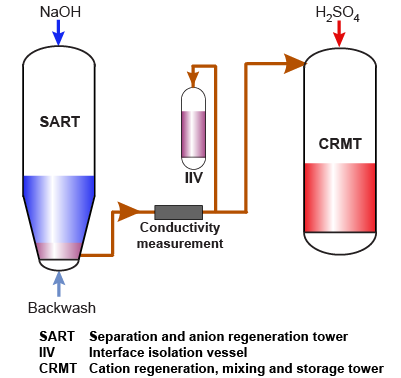
ConesepTM regeneration system
Process condensates
In miscellaneous industries other than power generation, process condensates may contain a variety of contaminants, and may have to be treated at high temperature. These condensates may contain following contaminants:- Hardness
- Iron
- Ammonia
- Methanol
- Urea
- Hydrocarbons
- Organic acids
- Organic amines
- Silica
- Other cations and anions
Mixed bed polishers are not suitable when the temperature exceeds 60 °C, because strongly basic ion exchange resins would degrade rapidly.
The most common process at high temperature is the use of a SAC resin in the Na cycle (softening), sometimes in the NH4 cycle.
What is removed, what is not?
- Softening option (any temperature up to 120 °C)
Practically only divalent cationic impurities are removed, plus a good part of the suspended solids. - Demin option (only below 60 °C)
Everything ionised is removed, which includes organic acids or amines if any. Silica is removed only if temperature is less than about 50°C. - Not removed
Alcohols, hydrocarbons, ketones, aldehydes, urea, carbohydrates (sugars), i.e. anything not ionised.
The softening option
A physically strong, oxidation-resistant resin must be used. Recommended choices are AmberliteTM IRC200 Na and AmberliteTM HPR2900 Na.
Operating conditions
| Specific flow rate | 40 to 80 bedvolumes per hour (BV/h) |
| Backwash | The resin must be thoroughly backwashed before regeneration |
| Regeneration | Co-flow or split-flow (see Columns) |
| Regenerant | NaCl or NH4OH |
| Reg. dosage | 140 to 200 g/L |
| Reg. concentration | About 10% |
| Potential problems | Iron and oil fouling |
Amberlite is a trademark of DuPont Water Solutions.





